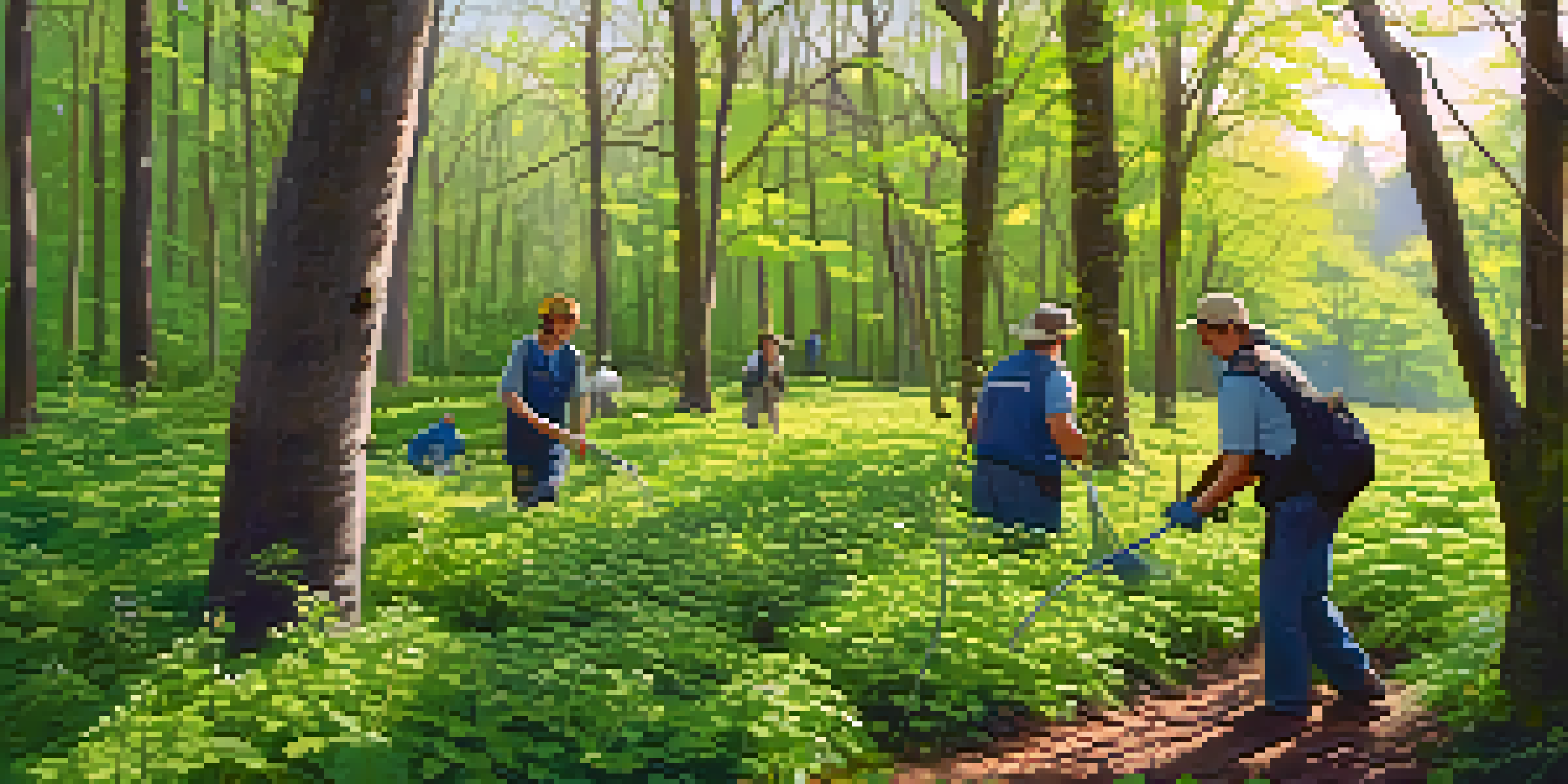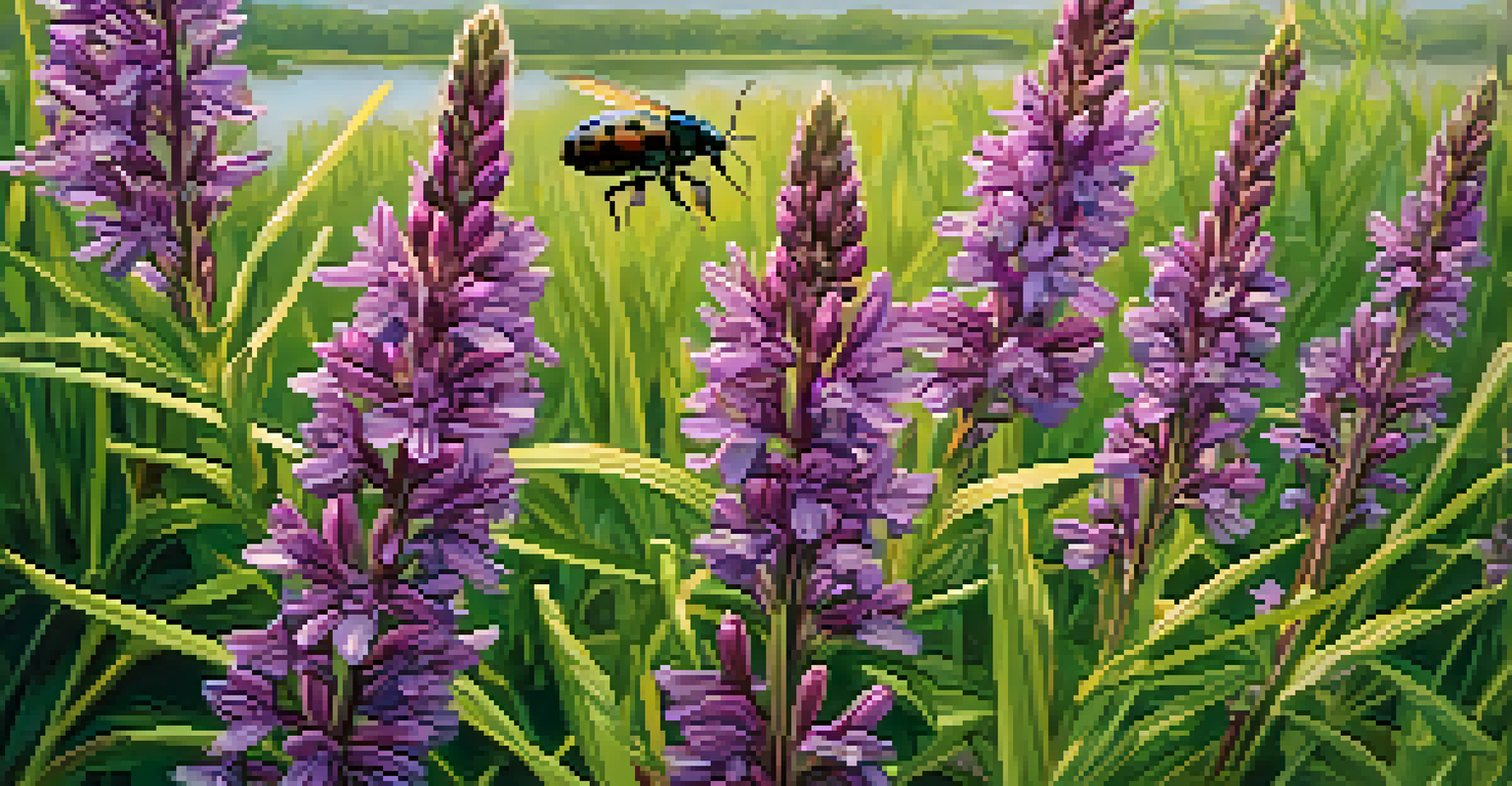Case Studies: Successful Management of Invasive Plants

Understanding Invasive Plants: A Growing Concern
Invasive plants are species that thrive in new environments, often outcompeting native flora. This can lead to significant ecological imbalances, as they disrupt local ecosystems and threaten biodiversity. Understanding the nature of these plants is crucial for developing effective management strategies.
Invasive species are the second greatest threat to biodiversity after habitat loss.
For example, species like kudzu in the southeastern United States can grow rapidly and blanket entire landscapes, smothering native plants in the process. This not only affects plant life but also the animals that depend on these native species for food and habitat. Recognizing the characteristics of invasive plants helps us target our management efforts more effectively.
Management strategies often hinge on understanding both the biology of the invasive species and the ecology of the affected area. By combining research with local knowledge, communities can tailor solutions that are both effective and sustainable.
Case Study: The Battle Against Garlic Mustard
Garlic mustard is an invasive plant that has spread across many regions in North America, outcompeting native plants and altering habitats. In one successful case, a community in Michigan launched a volunteer program to pull garlic mustard from local parks. This grassroots effort not only reduced the plant's prevalence but also raised awareness about the issue.

The volunteers learned about the plant's life cycle, which helped them time their efforts more effectively during the plant's growth phases. By focusing on removing the plants before they could seed, they significantly curtailed future growth. The community's involvement fostered a sense of stewardship over their local environment.
Community Efforts Drive Success
Local engagement in invasive plant management fosters stewardship and leads to tangible ecological improvements.
This case illustrates the power of community engagement in managing invasive species. When locals are educated and involved, not only can they achieve tangible results, but they also cultivate a deeper connection to their natural surroundings.
Case Study: Restoring Balance with Japanese Knotweed Control
Japanese knotweed is notorious for its resilience, often causing structural damage to buildings and roads. In the UK, a comprehensive approach to managing this invasive plant involved both mechanical removal and the use of targeted herbicides. This dual strategy helped to minimize the plant's spread while allowing for the restoration of native vegetation.
The best way to control invasive species is to prevent them from arriving in the first place.
The project included ongoing monitoring of treated areas to ensure that knotweed did not re-establish itself. By integrating regular assessments, the team could adapt their strategies as needed, demonstrating the importance of flexibility in management plans. Over time, native plants began to flourish in areas previously dominated by knotweed.
This case highlights how a multifaceted approach can yield success in battling particularly stubborn invaders. It underscores the need for continuous evaluation and adaptation in invasive plant management.
Case Study: The Role of Biological Control in Invasive Species
Biological control involves using natural predators or pathogens to manage invasive species. In the case of the purple loosestrife, an invasive wetland plant, researchers introduced specific beetles that feed on the plant. This method has shown promise in reducing populations without harming native species.
The introduction of these beetles was carefully monitored to ensure they would not negatively impact the local ecosystem. Over time, the beetle populations stabilized, leading to a noticeable decline in purple loosestrife growth. This case demonstrates the potential of biological control as a sustainable solution to invasive plant management.
Technology Enhances Management
Innovative tools like GIS and drones streamline efforts in mapping and monitoring invasive species.
However, biological control requires thorough research and planning to avoid unintended consequences. It serves as an example of how innovative approaches can complement traditional management practices.
Community Engagement: Empowering Local Management Efforts
Community involvement is essential in the fight against invasive plants. Successful programs often rely on local volunteers who contribute their time and effort to restoration projects. These initiatives not only address the immediate problem but also foster a sense of ownership and responsibility among participants.
For instance, a community in California organized regular removal events for invasive species like English ivy. By offering educational workshops alongside these events, they empowered residents with knowledge about the impacts of invasives and the importance of native plants. This approach not only engaged the community but also created lasting change.
Local engagement also helps to sustain long-term management efforts. When communities are invested, they are more likely to continue monitoring and maintaining their environments well into the future.
Innovative Tools: Technology in Invasive Plant Management
Advancements in technology are providing new avenues for managing invasive plants. Geographic Information Systems (GIS) allow researchers and land managers to map and analyze the distribution of invasive species effectively. This technology helps prioritize areas for action and track changes over time.
For example, a project in Florida used drones to survey large areas of land for invasive species like Brazilian pepper. This method improved efficiency and provided real-time data on plant distribution, enabling quicker responses to outbreaks. Utilizing technology can streamline efforts and improve overall effectiveness.
Adaptability is Key
Ongoing education, collaboration, and flexibility in strategies are essential for effective invasive plant management.
The integration of technology with traditional management practices illustrates a forward-thinking approach to conservation. By embracing new tools, we can enhance our ability to tackle complex environmental challenges.
Lessons Learned: Best Practices for Invasive Plant Management
The success stories surrounding invasive plant management reveal several best practices that can be applied broadly. One key takeaway is the importance of early detection and rapid response. Addressing invasives before they establish a stronghold can save significant time and resources later on.
Collaboration among stakeholders—be it local governments, non-profits, or community members—also plays a vital role. By pooling resources and expertise, communities can tackle invasive species more effectively and create a unified front. For instance, regional partnerships have proven successful in coordinating efforts across larger landscapes.

Finally, ongoing education and outreach are crucial for sustaining these efforts. Providing communities with the knowledge and tools they need empowers them to contribute meaningfully to invasive plant management and ensures that progress continues.
Looking Ahead: The Future of Invasive Plant Management
As the challenges posed by invasive plants continue to evolve, so must our management strategies. The future will likely see increased reliance on technology and community engagement, creating a more integrated approach to conservation. By harnessing innovations in science and community action, we can better protect our natural ecosystems.
Research into new methods, such as genetic control or advanced biological methods, shows promise for the next generation of invasive plant management. Additionally, public awareness campaigns can help educate broader audiences about the impacts of invasive species and the importance of biodiversity.
Ultimately, the key to success lies in adaptability and collaboration. By learning from past experiences and being open to new strategies, we can foster resilient ecosystems and safeguard our natural heritage for generations to come.